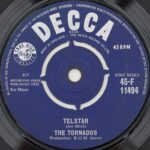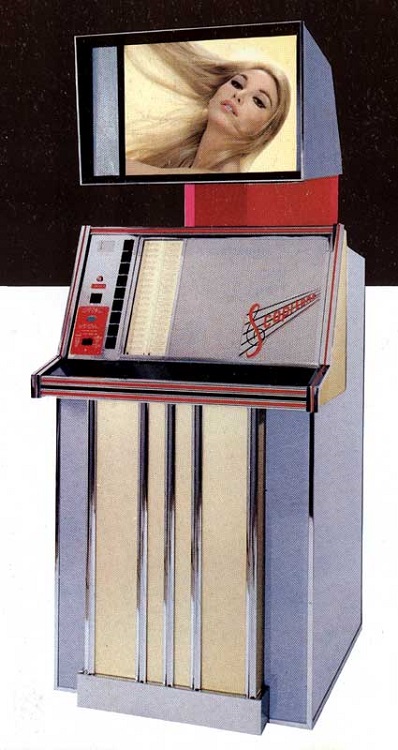 It’s not the first single I ever bought, but this is my first memory of the combination of music and film, a couple of decades before the pop video and MTV took hold. Where do you think the least likely place would be to see (and hear, because you certainly bloody heard it) a Scopitone film clip of a huge sixties tune. An instrumental that managed to imprint itself on my consciousness because it’s a cracking, ground-breaking tune and for another unrelated reason I’ll revisit later. That place was a pit canteen on the east coast of Fife and the tune was “Telstar” by The Tornados. Unlikely? Maybe, but true nevertheless.
It’s not the first single I ever bought, but this is my first memory of the combination of music and film, a couple of decades before the pop video and MTV took hold. Where do you think the least likely place would be to see (and hear, because you certainly bloody heard it) a Scopitone film clip of a huge sixties tune. An instrumental that managed to imprint itself on my consciousness because it’s a cracking, ground-breaking tune and for another unrelated reason I’ll revisit later. That place was a pit canteen on the east coast of Fife and the tune was “Telstar” by The Tornados. Unlikely? Maybe, but true nevertheless.
It seems unlikely now, but at that time, nearly sixty years ago, the Fife coast between Kirkcaldy and Methil was a string of mines ripping coal out from underneath the River Forth. The Michael Colliery in East Wemyss was just one of those mines, providing work for the community and blackening the coastline. South-west of Kirkcaldy and north-east of Methil the beaches were golden; between those two towns, the coast was a uniform black and it’s just beginning to recover now, fifty years after the mines closed.
The villages along this stretch of coast, Dysart, West Wemyss, Coaltown of Wemyss, East Wemyss, Buckhaven (Buckhyne if you’re a true Fifer) and Methil were mining communities and the pit canteen was as much of a social hub as the local pub or club. I don’t know about The Frances in Dysart (or The Dubbie as we knew it) or The Wellesley in Buckhaven, but The Michael in the early sixties had a Scopitone video jukebox and it was the eighth wonder of the world. My introduction to this wonderful device changed my life forever.
In a small village and tight-knit community, news spreads quickly and the installation of a jukebox that showed films had as much of an impact as the Cuban missile crisis. Security at the Michael site was non-existent and anyone could walk in to the canteen, so why wouldn’t you just do it, even at the age of seven. Obviously, I didn’t have any money to feed the Scopitone beast when I made my first visit to its lair, but it didn’t matter; someone with incredibly good musical taste had already fed the monster. I looked the Scopitone in the eye and waited for a reaction.
Exciting doesn’t really do it justice; the sound that came out of that beast was breath-taking and it was combined with film of The Tornados and a satellite launch. Like most jukeboxes, the tube amplifier was powerful and definitely not subtle. It was all about excitement and maximum impact; combine the pulsing sci-fi sound effects and the ascending organ pattern of the intro leading up to the eruption of the main melody with a shot of a Saturn I thrusting upwards into space spliced with shots of the band performing on 16mm colour film and you have something that, for me, was literally out of this world. From that moment on I was hooked. I liked the pop music of the time when I got to hear it on the radio or on a small black and white TV, but this was something completely different; it was loud, it was visceral and impossible to ignore. I knew that I wanted more of it, and I still do.
It was only years later that I understood the significance of Telstar’s creator, Joe Meek, in pop history, but I knew at the time that I had heard a glorious noise and I was desperate to hear more of the same.

Le Scopitone was a French invention that achieved limited success despite its great potential as a promotional tool. It was bulky but reasonably reliable, although the number of songs was limited compared to an audio-only jukebox and production costs were obviously much higher where film was involved. Also, Scopitone never managed to lure the real superstars of the time to the format. It managed to survive until 1978 (only three years before the official launch of MTV) when it succumbed to the new, more cost-effective, video tape. I hope Le Scopitone had the same effect on others as it had on me.
Let’s get back to “Telstar” and the other association that explains why I love this tune so much. From about the age of five, my dad took me to Bayview (where the terraces were made of railway sleepers and gravel, with the odd crush barrier) to watch our local team East Fife, hoisting me over the turnstile so it wouldn’t register and he wouldn’t have to pay for me. A huge part of the ritual is applauding your team on to the pitch as the run-on music plays and you can probably guess by now what the run-on music was at Bayview. Fifty-five years and more (and a few relocations) have passed since then, but my team is still East Fife and they still run on to “Telstar” at New Bayview on the banks of The Forth. Some things don’t need to change or be improved.
And I still love to listen to “Telstar”, preferably my 7” vinyl copy. The anticipation as the stylus touches down and, the crackles and scratches and the rush as the intro builds up all take me back to that day in a pit canteen in East Wemyss, a lifetime ago.
Finally, a couple of pieces of trivia for you. The legendary Clem Cattini played drums on “Telstar” and George Bellamy (father of Muse’s Matt) played rhythm guitar – did you ever wonder where “Knights of Cydonia” came from?
 Ok, I admit it, we’re a bit late out of the blocks with this one and the reason we’re finally reviewing “Sexploitation” is that Anna-Christina from Lilygun pointed me in the direction of Star Scream; good spot A-C, as ever. Songwriter Adam Lightspeed fronts the band mixing guitar and keyboards with lead vocals and the trio is completed by Natalie Cherry (bass and backing vocals) and Sky London (drums and percussion). With that particular line-up, you probably won’t be too surprised if I tell you that Muse is acknowledged as a major influence. The album is dotted with references to a wide variety of styles and eras, stitched together with such skill, style and unpredictability that the end result is a unique collage.
Ok, I admit it, we’re a bit late out of the blocks with this one and the reason we’re finally reviewing “Sexploitation” is that Anna-Christina from Lilygun pointed me in the direction of Star Scream; good spot A-C, as ever. Songwriter Adam Lightspeed fronts the band mixing guitar and keyboards with lead vocals and the trio is completed by Natalie Cherry (bass and backing vocals) and Sky London (drums and percussion). With that particular line-up, you probably won’t be too surprised if I tell you that Muse is acknowledged as a major influence. The album is dotted with references to a wide variety of styles and eras, stitched together with such skill, style and unpredictability that the end result is a unique collage.
The album opens with the camp theatricality of “Roseblood (Weeping Willow)”, a seedy, sordid tale of exploitation in the skin trade and an arrangement which echoes the Sensational Alex Harvey Band from the early 70s. “Die on the Floor” is another reference to the 70s, fusing a Marc Bolan vocal style with a Sweet stomp and maybe even a bit of early Giorgio Moroder to set the scene for the rest of the album.
When the playing and the dynamics are this good, it’s easy to focus on the music at the expense of the lyrics; if you do, you’re only getting half the picture. Adam is obviously a writer who likes a bit of wordplay and it comes through in some of the titles: the riff-monster “Harlot’s Web”, “Frightmare” and the stomper, “Kill me Kate”. And it doesn’t stop at that; there are some clever turns of phrase in the lyrics as well; how about ‘knight in shining Armani’ from “Frightmare”, and my favourite portmanteau word for the week ‘conspiranoia’, from the hard-riffing glam satire of the current music scene, “Death Shower Scene”. I suspect they ordered in extra kitchen sinks for that one.
Towards the end of the album there are three songs linked by the theme of transgressive or dysfunctional relationships. The trio starts with “Kill me Kate”, progresses through “As the Earth Dies Screaming” with its very effective use of loud-soft dynamics to “Heart of Ice (Falling Out of Love)” which builds by adding instrumental layers for each verse. For once Adam’s voice isn’t on the ragged edge throughout and in the opening verses there’s a hint of Stephen Duffy’s voice (remember him?).
The album’s third and fourth songs also share a theme both poking fun at the faces, the alpha males and females at the forefront of any scene. “Break the Night” is probably the album’s most heavily Muse–influenced song, particularly the vocals and the guitar solo, while “Scenester” pulls influences from everywhere. The song opens like the Clash version of “Brand New Cadillac”, has a breakdown with manic left to right percussion panning, a second breakdown for live audience participation and a guitar solo which would fit perfectly on a Joe Meek record and a crash ending. What more could you want?
The more reflective moments are all towards the end of the album, starting with “When Crimson Lips Spell Murder” which makes good use of dynamics before ending with a delicate string quartet coda. The final big production number, “Obsession”, is built around a sequenced synth riff which loops almost throughout the song, while a piano hook on top adds to the over-the-top Muse feel of the song. The album closes with the stripped-back “The Girl Who Was Death” (just acoustic guitar, strings and some lovely harmonies) and a lead vocal which sounds a lot like Greg Dulli.
“Sexploitation” is an album that grips you because you just don’t know what’s coming next; imagine throwing a lit match into a box of fireworks and you’re about halfway there. The influences are all very transparent but they’re woven so subtly into the rich and contrasting fabric of the songs that they seem to belong there. But it isn’t just about big guitars and thunderous drums; the band use dynamics really effectively and the lyrics are actually worth listening to. In a world of manufactured pop pap and over-hyped ‘next big thing’ acts (did someone mention Royal Blood) this album is a reminder that the real talent is still out there.
Available now from Amazon, iTunes or the band’s website.


